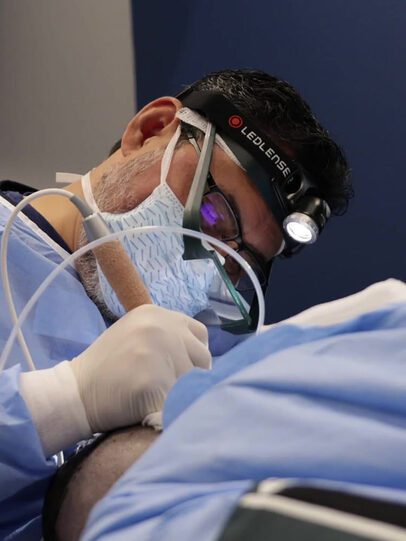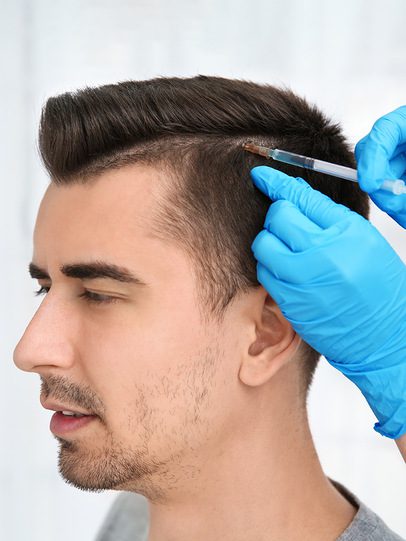Are you troubled by thinning hair or balding spots on your scalp?
It’s a common issue that can profoundly affect your confidence and self-esteem. Whether you’re facing receding hairlines, patchy areas, or noticeable hair loss, the struggle with scalp-related concerns is undeniable. Many individuals experiencing hair loss on their scalp feel self-conscious in various social settings or dissatisfied with their overall appearance. At AdvancedYOU Hair Restoration, we recognize the emotional strain associated with these challenges. That’s why we specialize in scalp restoration, providing customized solutions to help you reclaim the full, healthy hair you desire. Our committed team is dedicated to guiding you through each phase of the process, offering innovative treatments tailored to your unique needs.
Advanced Strategies for Thinning and Early Hair Loss in Men
Thinning hair rarely starts overnight. For most men, it’s a gradual shift. At first, it may be less dense, it may be harder to style, or there may be a subtle but growing patch of scalp that becomes more visible under the light. If any of these describe the changes taking place on your scalp, especially at the crown, you may feel helpless. But you don’t have to accept hair loss or thinning as a sign of inevitable baldness.
At AdvancedYOU Hair Restoration, we specialize in diagnosing and treating the earliest signs of male pattern thinning with clinically backed, personalized solutions. Whether your goal is to slow the progression of hair loss, reverse thinning, or permanently restore density, we’re here to help you understand your options and regain confidence—on your terms.
Why Thinning Hair Deserves a Closer Look
Hair loss can feel like it’s all about aesthetics, but you know it’s more than that. It’s about how you see yourself when you look in the mirror, how you show up in your career, and how you believe others see you.
The most common cause of hair thinning in men is androgenetic alopecia, often referred to as male pattern baldness. This condition is driven by dihydrotestosterone (DHT), a hormone that slowly shrinks hair follicles, making them weaker and shorter with each growth cycle until they eventually stop producing hair. But genetics aren’t the only variable. Hormonal imbalances, nutritional deficiencies, stress, and even daily styling habits can all contribute to follicular stress and miniaturization.
That’s why our approach at AdvancedYOU is always comprehensive. We evaluate the full picture, including both internal and external factors, so we can develop a treatment plan that addresses not just symptoms but root causes.
Are you a good candidate for Scalp Hair Restoration?
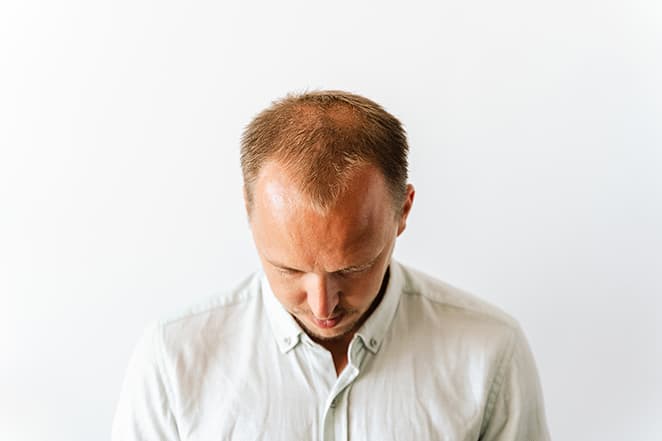
Scalp Restoration for Men
Men who are good candidates for scalp restoration may observe the typical hair loss of male pattern baldness. This often manifests as thinning hair on the top of the head, particularly around the crown area. This pattern can progress to form a horseshoe shape of hair around the sides and back of the head, with more extensive hair loss on the crown. Men noticing such patterns of hair thinning or loss are prime candidates for scalp restoration procedures. Additionally, they should be healthy and possess adequate donor hair if they consider transplantation.
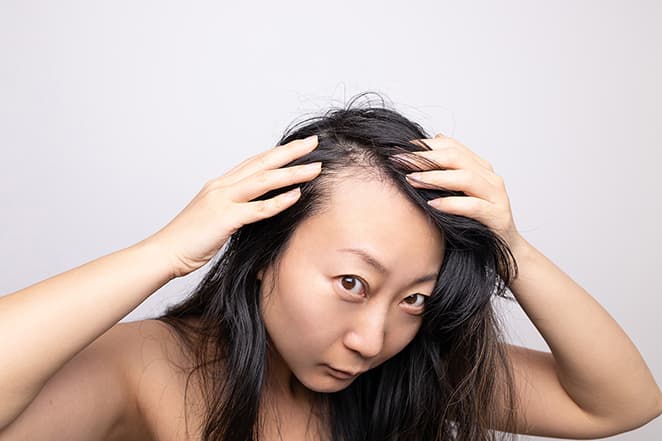
Scalp Restoration for Women
Women who are suitable candidates for scalp restoration typically experience hair thinning or loss on the scalp due to various factors such as hormonal changes, genetics, or medical conditions like alopecia. Women who notice widening parts, overall thinning, or bald patches on the scalp may benefit from this procedure. Candidates need to be in good health and have sufficient donor hair available on the scalp or from other areas of the body if they are considering transplantation.
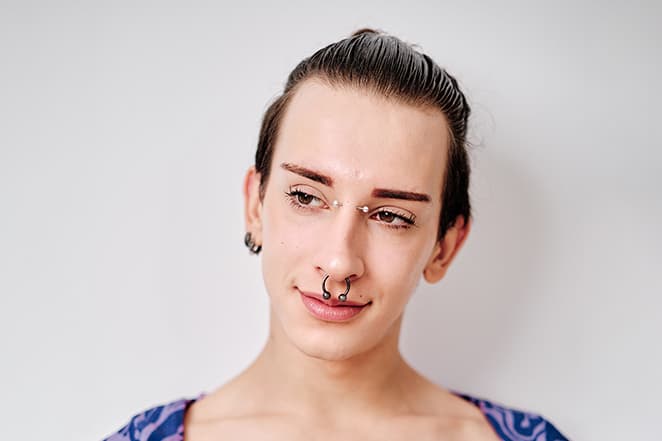
Scalp Restoration for Transgender Women
Transgender women who are good candidates for scalp restoration are individuals seeking to feminize their hairline and achieve the specific traits associated with a feminine hairline. These candidates often desire a softer, rounded shape to their hairline, with a more delicate and natural appearance. They may be troubled by a receding or masculine-patterned hairline and seek to create a smoother transition between their forehead and hair. Candidates must be healthy and have sufficient donor hair available if they consider hair transplantation.

Scalp Restoration for Transgender Men
Transgender Men who are good candidates for scalp restoration are individuals seeking to transition from a feminine to a masculine hairline. These candidates often find themselves distressed by the presence of a feminine or rounded hairline and aspire to achieve the specific traits associated with a male-patterned hairline. Ideal candidates for this procedure are transgender men who desire a more defined and angular shape to their hairline, with recession at the temples and a higher placement along the forehead. Candidates should be healthy and possess sufficient donors if considering hair transplantation.
Why the Crown Goes First
The crown of your head also called the vertex, is often the first area to show signs of thinning. The growth pattern here is spiral-shaped, making it especially vulnerable to DHT. The scalp in this zone also tends to receive less blood flow than the frontal hairline, which means the follicles here are more prone to miniaturization and more resistant to regrowth without intervention.
Maybe you’ve started noticing a widening part, a hard-to-style cowlick, or scalp glare under direct lighting. These are early signs that your crown may be thinning. And while it may seem easy to brush off in the beginning, it’s exactly the kind of change that’s easiest to treat when caught early.
At AdvancedYOU, we treat crown thinning with a level of precision that matches the complexity of this area. Hair transplants for a thinning crown can restore not only volume but also pattern by rebuilding your natural swirl and density with careful follicular placement and design.
SmartGraft FUE is a Proven Solution for Crown Restoration
When crown thinning becomes more visible or advanced, Follicular Unit Extraction (FUE) is often the most effective and permanent solution available. At AdvancedYOU, we use the SmartGraft® system, an automated, minimally invasive technology that delivers superior accuracy, faster recovery, and natural, long-term results.
With SmartGraft, we gently extract individual follicles from donor areas, typically the back and sides of your scalp, where follicles are naturally resistant to DHT. We transplant them into thinning areas. Unlike older strip-harvest methods, there’s no need for scalpels or sutures, leaving minimal scarring.
What sets SmartGraft apart is how it optimizes every step of the process, from harvest to preservation to implantation. SmartGraft procedures ensure high graft viability, as well as improving patient comfort throughout the procedure. And with our advanced planning and design, we’ll restore your hair in a way that respects its natural growth direction and flow.
Exosome Therapy: Non-Surgical Support for Early Thinning
If your hair loss is still in its early stages, or if you want to boost the results of a transplant, exosome therapy offers a powerful, non-invasive approach to rejuvenation. Exosomes are tiny, regenerative messengers derived from stem cells. When injected into the scalp, they help reactivate dormant follicles, reduce inflammation, and improve blood flow, creating a healthier environment for new hair growth.
This treatment is ideal for men who have mild crown thinning, diffuse loss, or slow shedding that hasn’t yet resulted in bald spots. Exosomes can help you preserve your existing hair, increase strand thickness, and extend the life of active follicles. For patients undergoing SmartGraft FUE, exosomes can also enhance healing and support surrounding follicles, improving overall density and texture.
The procedure is quick, comfortable, and typically completed in under an hour with no downtime and minimal aftercare required.
Areas for Restoration
Men

Hairline

Crown
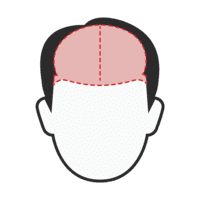
All over
Women

Hairline

Crown

All over
Wondering if you qualify as an ideal candidate for hair restoration? Take our assessment questionnaire to determine if this innovative solution meets your individual needs.
Early Action Makes All the Difference
One of the most common regrets we hear from new patients is that they waited too long to act. By the time a bald spot is clearly visible, many of the follicles in that area have already stopped functioning. And while we can still restore hair in those areas surgically, early intervention often opens the door to non-surgical or combination treatments that preserve what you already have.
At AdvancedYOU, your scalp restoration journey starts with a thorough diagnostic consultation. We examine your scalp health, follicular density, hormonal markers, and lifestyle factors to determine whether you’re a candidate for exosomes, SmartGraft, or a customized plan that includes both.
We’ll help you answer key questions like:
- Is my crown thinning or balding?
- Are my follicles still active?
- Can I stop this from getting worse?
- What’s the most effective next step?
Once we understand what’s going on, we’ll walk you through your options—clearly, transparently, and without pressure.
Your Hair Loss Story Is Personal. So Is Our Approach.
There’s no universal solution to hair loss because no two people experience it in the same way. At AdvancedYOU, we tailor every restoration strategy to match your goals, lifestyle, and stage of thinning. Some patients are just starting to notice changes. Others have been living with hair loss for years. Wherever you are in your journey, we’ll meet you there and help you move forward.
We don’t just offer SmartGraft hair transplants to thicken hair and exosomes. We offer guidance, planning, and personalized treatment with a focus on natural results that look and feel like your own hair.
When you work with us, you’re not getting a generic fix. You’re getting a clinically sound, custom-tailored restoration designed by specialists who understand both the science and the aesthetics of hair restoration.
Discover Hair Restoration Solutions for Men
Smart Graft® Hair Restoration
Hair Restoration with Exosomes
Hair restoration with exosomes is a regenerative therapy that utilizes stem cell exosomes to stimulate hair follicles and trigger new hair growth. At Advanced YOU, we use Exosomes derived from “Day Zero” stem cells, in the purest and most potent state, taken directly from the tissue of umbilical cords at birth and harvested immediately. The therapy contains 400+ unique growth factors (regenerative proteins) formulated for hair restoration. Our team infuses this cutting-edge hair restoration therapy into the desired area during the treatment to help stimulate hair regrowth. This therapy, combined with SmartGraft ®, enhances hair restoration results!
Hyperbaric Oxygen Therapy (HBOT)
Hyperbaric oxygen therapy (HBOT) is a medical treatment that involves breathing pure oxygen in a pressurized chamber, which increases the amount of oxygen delivered to the body’s tissues. At the same time, HBOT is effective as a complementary therapy following SmartGraft® FUE (Follicular Unit Extraction) hair restoration. The transplanted hair follicles require a sufficient oxygen supply to survive and thrive. HBOT enhances the blood supply to the hairline follicles, improving graft survival rates and accelerating healing.
Red Light Therapy
Red light therapy uses specific wavelengths of low-intensity red light to rejuvenate and stimulate the hair follicles. This non-invasive treatment is gaining popularity as a safe and effective method of promoting hair growth. The light energy from the device stimulates blood circulation and encourages cell repair and regeneration. The treatment directly targets the hair of the desired area, rejuvenating weakened follicles and promoting the growth of thicker, healthier hair. Patients sit back and relax during the procedure as the light penetrates the treatment area.
Wondering if you qualify as an ideal candidate for hair restoration? Take our assessment questionnaire to determine if this innovative solution meets your individual needs.


